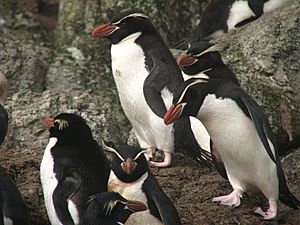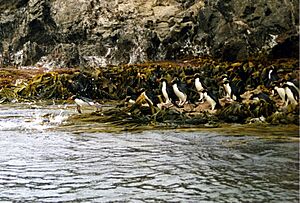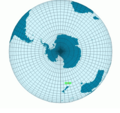Snares penguin facts for kids
Quick facts for kids Snares Penguin |
|
|---|---|
 |
|
| Conservation status | |
| Scientific classification | |
| Genus: |
Eudyptes
|
| Species: |
robustus
|
 |
|
| Distribution of the Snares penguin in green | |
The Snares penguin (Eudyptes robustus) is a special type of crested penguin. These penguins live in New Zealand. They are about 50-70 cm (20-28 inches) tall and weigh between 2.5-4 kg (5.5-9 pounds).
They build their nests and raise their young on The Snares, a small group of islands south of New Zealand's South Island. Scientists think they might be a type of subspecies of the Fiordland penguin.
Contents
What Do Snares Penguins Look Like?
Snares penguins look a lot like their relatives, the Fiordland penguins. Both are part of the Eudyptes group of crested penguins. You can tell a Snares penguin apart by a small patch of bare skin at the base of its beak.
Like many other penguins, they have a black head, back, and flippers. Their belly is white. They have a bright yellow crest of feathers. This crest starts near their beak and goes along the top of their head to the back. Their beak is thick and reddish-brown, with light pink skin at the base. Their eyes are usually a bright red-brown color.
Snares penguins make many different sounds. They can hiss or make loud cries if they feel threatened. They also make rhythmic braying and trumpeting sounds. These loud calls can be heard from far away when they are at sea.
Where Do Snares Penguins Live?
The Snares penguin gets its name from the Snares Islands. This is where they come to breed and raise their chicks. These islands are a small group located off the coast of southern New Zealand.
We don't know much about where they go when it's not breeding season. However, scientists believe they don't travel very far in the winter. Sometimes, they have been seen in other places. These include the coasts of Tasmania, southern Australia, the Chatham Islands, Stewart Island, and the southern New Zealand mainland. There are about 25,000 pairs of Snares penguins alive today.
Snares penguins build their nests in large groups called colonies. They often choose spots under the trees in Olearia forests or on coastal rocks. To make a nest, they dig shallow holes in the ground. They line the bottom with grass, leaves, twigs, or small pebbles. They add a small rim of mud around the edge to keep the nest dry.
Sometimes, too many penguins nesting in one spot can cause the plants to die. When this happens, the colony moves to a new nesting area. Some colonies nest near streams, which gives them water for drinking and bathing. But many colonies are far from streams and do just fine.
Protecting Snares Penguins
Snares penguins are not currently in danger of disappearing. However, they are considered a vulnerable species. This means that if a big threat came along, it could quickly harm their population. This is because all their breeding grounds are on one small group of islands.
Possible threats include new predators arriving on the islands. Overfishing around the islands could also reduce their food supply. Rising water temperatures from global warming might push their food away. Pollution is another concern. The New Zealand government is working to protect the Snares Islands and the ocean areas where these penguins find food.
Behavior
What Do Snares Penguins Eat?
Snares penguins mostly eat small sea creatures. Their diet usually includes krill (a type of tiny shrimp), small fish, and cephalopods like squid.
One study found that about 60% of what they ate was krill. Fish made up about 30%, and cephalopods were about 10%. Another study showed slightly different numbers. But both studies agreed that fish and cephalopods are very important foods for adult penguins when they are out at sea.
How Do Snares Penguins Find Food?
The way Snares penguins find food changes during the breeding season. After both parents take turns sitting on the eggs, the male penguin goes on a long fishing trip. This trip lasts about two weeks. It happens when there is a lot of tiny sea life (plankton) in the ocean, which means plenty of food.
When the male returns, the female goes on a shorter trip, usually less than a week. She comes back just before the chicks hatch. Once the chicks are born, the female is the main one who finds food for them. She makes short trips, lasting one to three days.
Male penguins on long trips can dive deep, up to 120 meters (about 400 feet). But when they are raising chicks, they usually dive shallower, around 20-40 meters (65-130 feet). This helps them catch prey more easily for their young.
Who Are Their Predators?
Adult Snares penguins can be hunted by larger ocean animals. These include sea lions and leopard seals. Their eggs and young chicks are also in danger. Birds like skuas and petrels sometimes try to eat them.
Life Cycle and Reproduction
The breeding season for Snares penguins happens during the New Zealand summer. It starts in early September and finishes in late January. Snares penguins usually begin having chicks when they are between five and nine years old.
To attract a female, a male penguin stands tall with his wings spread. He pumps his chest. It's likely that penguin pairs stay together for many breeding seasons. The pair then builds a nest, with the male doing most of the work.
The female lays two eggs, usually about three to five days apart. The eggs hatch after 31–37 days. The second egg laid is often much larger than the first. It also hatches first! The smaller chick that hatches last often struggles to get enough food. It usually doesn't survive because its larger sibling outcompetes it. This is a natural process called "siblicide."
Snares penguins are special because their second egg is bigger and hatches first. In most other birds, the last egg laid is the smallest and hatches last. Both parents take turns sitting on the eggs to keep them warm. For the first ten days, they switch often. Then, the male leaves for about 12 days to find food. The mother stays with the eggs. When he comes back, they switch roles. When the male returns, the pair bows and makes trumpeting sounds. This helps make their bond stronger.
For the first three weeks after the chicks hatch, the male penguin guards them. The female goes to find food, returning every day to feed her young. Parents can recognize their chicks, and chicks can recognize their parents. They use their calls more than what they see to know each other. The parents feed their young every day until the chicks grow new feathers and can find their own food. The young penguins are ready to leave the nest at about 11 weeks old.
Images for kids
See also
 In Spanish: Pingüino de las Snares para niños
In Spanish: Pingüino de las Snares para niños





